|
Collembola
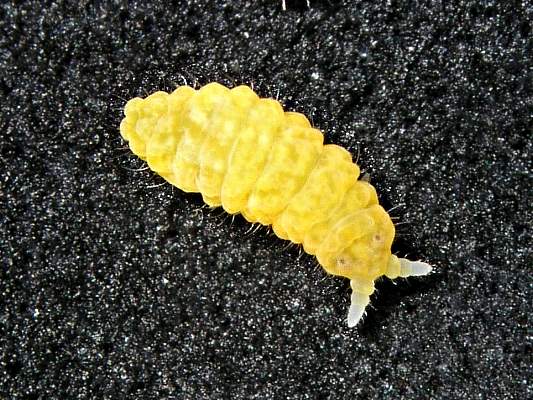
A springtail (Collembola) from New Zealand.
Common name: springtails, Maori tawhana.
Scientific name: phylum Arthropoda, class Collembola Lubbock, 1870 — from Greek “cole”, glue, and “embolon”, peg or piston.
Description
Collembola (springtails) are small animals, generally 2-3 mm in length. The smallest springtails are only 0.2 mm in length, the largest springtails found in New Zealand reach about 8 mm. All springtails are wingless. The soft body is divided into the head, the thorax with three segments, and the abdomen with six segments. The head bears a pair of antennae, two postantennal organs, eyes and mouthparts. Each eye, if present, consists of one to eight ommatidia (eye spots). Many Collembola are eyeless.
Most, but not all Collembola are able to
jump using a forked abdominal appendage, the furca —
hence the name “springtails”. The furca is held
by a special catch mechanism which, when released, acts as
a spring, throwing the springtail as far as 10-15 cm away.
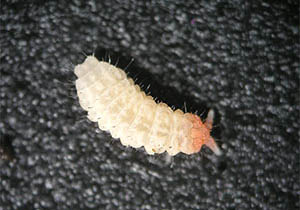
A soil-dwelling poduromorph springtail, North Island of New Zealand. |
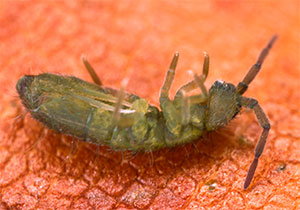
The jumping organ - the furca - is visible on this springtail. Image courtesy of Steve Hopkin©. |
Within Collembola, several body types exist.
Some springtails (known as Poduromorpha, these
are mostly soil dwellers) are stout, with short antennae, short legs,
and robust elongated body. They are often coloured
in blue, pink, purple or white. Other Collembola have long antennae
and legs, and elongated bodies in shades of brown, grey, or
purple which are often striped or irridescent (Entomobryomorpha, the inhabitants of the litter surface). Yet another
group (order Symphypleona) are almost globular in shape, brightly
coloured, active and easily noticed. As a rule, the surface-dwelling
species are colourful and have well-developed dark eyes, while
deeper soil-dwelling species are often white and eyeless,
and have reduced furca. Collembola are one of the oldest groups
of terrestrial arthropods, dating back to the Devonian period,
400 million years ago. Collembola and insects share a common
ancestor.
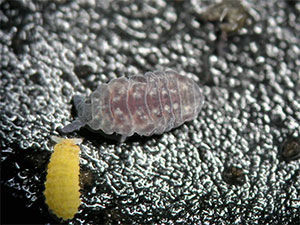
These two poduromorph Collembola live in the rotting wood. North Island of New Zealand. |
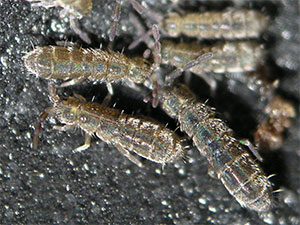
A group of active, surface-dwelling springtails (family Isotomidae), North Island of New Zealand. |
Notes on biology
The diet of springtails consists of decaying
vegetation and associated bacteria and fungi. Some are specialised
fungal feeders. Collembola are also known to eat nematodes
and dead animal matter. In greenhouses and gardens Collembola
have been known to reproduce in masses and damage seedlings
and young lettuce. The large surface-dwelling species Sminthurus
viridis, the “lucerne flea”, can cause serious
damage to peas, clover and alfalfa crops.
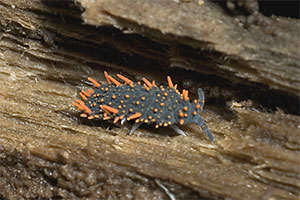 Holacanthella paucispinosa Holacanthella paucispinosa, an endemic New Zealand species. This springtail inhabits dead wood and can reach
8 mm in size. Canterbury, New Zealand. Springtails have separate sexes. Sperm transfer
is indirect — males produce small packets of sperm (spermatophores)
and leave them on a substrate, where they are found and picked
up by the females. Some species are parthenogenetic (all-female,
reproducing without males). Females deposit their eggs on
a surface and abandon them. In some species, eggs are capable
of a long diapause. Development is direct, with juveniles
resembling adults except they are smaller in size and have
slightly different proportions. Juvenile Collembola grow and
undergo 3-12 moults before they become sexually mature. Adult
Collembola continue to moult regularly throughout their life
(up to 50 times during their lifetime) and continue to grow
slowly, although not indefinitely. The life span of springtails
is short - usually less than a year, although some species
live longer.
Many springtails are opportunistic species capable of rapid population growth. Under favourable conditions they can reach densities of more than 100 individuals per square centimeter. Collembola make up a significant proportion of the animal biomass in most soils. They play an important role in decomposition and nutrient cycling in soil ecosystems, and are a major food source for a variety of soil predators.
Where to find them?
Springtails are omnipresent members of soil
fauna, they inhabit both the surface and the depth of the
soil, and often occur in large aggregations. Like many soil
animals, Collembola prefer dark, damp habitats. Collembola
are easily found. They can often be seen in large numbers
under overturned rotting logs, under loose tree bark, in leaf
litter or in compost, and can be instantly recognised by their
ability to jump as they try to escape from the light. The
larger surface-dwelling species can be often observed in the
open.
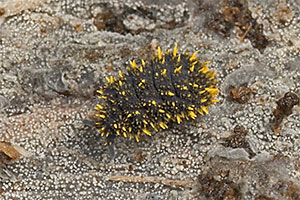 Holacanthella spinosa
Holacanthella spinosa, another endemic springtail
from rotting wood. Canterbury, New Zealand. Because of their small size and agility, catching live springtails is difficult. The most effective way to collect them is by using a Berlese funnel. Pitfall traps are useful to capture many of the larger surface-dwelling species, which often escape successfully from litter samples. Individual springtails can be collected using a hand-held aspirator. Collected springtails can be preserved in 75% alcohol.
Some Collembola can be kept in captivity in small tightly closed jars, on a substrate made of 9:1 mix of plaster of Paris and powdered charcoal. Collembola can be fed small amounts of baker's yeast and/or microscopic green algae — the type that often cover the surfaces of damp wood and tree bark. Visit the Collcare web page to find out more.
Distribution and conservation
There are more than 6 000 described species
in the world, with many more species still unknown to us.
Collembola are ubiquitous members of terrestrial ecosystems,
found everywhere from Antarctica and the sub-Antarctic islands
to rainforests and warm beaches. Springtails can be dispersed
by wind and ocean currents, or by man, and many species have
wide distribution ranges.
At least 241 species of Collembola are known
from New Zealand, and many more are still undescribed. In
New Zealand occur some of the largest and most extraordinary
CoIlembola found anywhere in the world, such as endemic Holacanthella
species. Collembola are too small and too numerous to be considered
animals in need of conservation. They are not protected in
New Zealand, although the giant endemic species are remarkable.
In Tasmania there is a reserve dedicated solely to a species of Collembola, Tasphorura vesiculata. It is called the Springtail Reserve.
Included images:
- Family Neanuridae
- Holacanthella paucispinosa (Salmon, 1941) - Hawdon Valley, NC, South Island (4 images)
- Holacanthella spinosa (Lubbock, 1899) - Hawdon Valley, NC, South Island (3 images)
- Holacanthella duospinosa (Salmon, 1942) - Kaituna Track, NN, South Island (3 images)
- Holacanthella brevispinosa (Salmon, 1942) - Aorere Valley, NN, South Island (2 images)
- ?Ceratrimeria? sp. - Kawhatau Base, RI, North Island (2 images)
- Family ?Neanuridae?
- ?Ceratrimeria? sp. - Mt. Aspiring National Park, Rob Roy Glacier Track, Western Otago, WD, South Island
- Family Hypogastruridae
- Unidentified species - Peel Forest Park, Dennistoun Bush, SC, South Island
- Family ?Hypogastruridae?
- Unidentified species - Kawhatau Base, RI, North Island (2 images)
- Unidentified species - Kawhatau Base, RI, North Island (2 images)
- Unidentified species - Kawhatau Base, RI, North Island (3 images)
- Unidentified species - Palmerston North, WI, North Island
- Other
- Unidentified species - Temple Valley, Lake Ohau, MK, South Island
- Unidentified species - Kawhatau Base, RI, North Island (2 images)
- Unidentified species - Kawhatau Base, RI, North Island (2 images)
- * - species exotic in NZ
Further information on New Zealand
springtails:
Adams, E.C.G. 1971. Ecological studies of
microarthropods in a New Zealand pasture soil with special
reference to Collembola. Pedobiologia 11, p. 321.
Assalino, M.M.D., Greenslade P. 1981. Relationships
between the distribution and phylogeny of Xenylla (Collembola,
Hypogastruridae) species in Australia and New Zealand. Revue
d'Ecologie et de Biolobie du Sol 18, p. 269-284.
Christiansen, K.A. 1990. Insecta: Collembola.
In: Dindal D.L. (ed.) Soil Biology Guide. J. Wiley & Sons,
New York, p. 965-995.
Deharveng, L., Wise, K.A.J. 1987. A new
genus of Collembola (Neanuridae Neanurinae) from Southern
New Zealand. Records of the Auckland Institute and Museum
24, p. 143-146.
Foster, W. 1977. A zonal distribution of
Collembola from Mt. Ruapehu. Unpublished BSc (Honors) thesis.
Victoria University, Wellington.
Greenslade, P., Wise, K.A.J. 1986. Collembola
of Macquarie Island. Record of the Auckland Institute Museum
23, p. 67-97.
Luxton, M. 1982. Studies on the invertebrate
fauna of New Zealand peat soils. Part I-II. Revue d'Ecologie
et de Biologie du Sol 19, p. 535-578.
Luxton, M. 1982. Studies on the invertebrate
fauna of New Zealand peat soils. Part IV. Pedobiologia 24,
p. 297-308.
Luxton, M. 1983. Studies on the invertebrate
fauna of New Zealand peat soils. Part III. Revue d'Ecologie
et de Biologie du Sol 20, p. 87-109.
Luxton, M. 1983. Studies on the invertebrate
fauna of New Zealand peat soils. Part V. Pedobiologia 25,
p. 135-148.
Salmon, J.T. 1941. The Collembola fauna
of New Zealand, including a discussion of the distribution
and affinities. Transactions of the Royal Society of New Zealand
70, p. 282-431.
Salmon, J.T. 1951. Keys and bibliography
to the Collembola. Zoology Publications from Victoria University
College (Wellington, New Zealand) 8, p. 1-82.
Salmon, J.T. 1964-1965. An index to the
Collembola. Bulletin of the Royal Society of New Zealand,
Vol. 1, 1964, pp. 1-144; Vol. 2, 1964, p. 145-644; Vol. 3,
1965, p. 645-651.
Stevens, M.I., Hogg I.D. 2002. Expanded
distributional records of Collembola and Acari in southern
Victoria Land, Antarctica. Pedobiologia 46, p. 485-495.
Stevens, M., Winter, D., Morris, R., McCartney,
J., Greenslade, P. 2007. New Zealand's giant Collembola: New
information on distribution and morphology for Holacanthella
Börner, 1906 (Neanuridae: Uchidanurinae). New Zealand
Journal of Zoology 34: 63-78.
Ward, J.B., Macfarlane R.P., Quinn P.J.,
et al. 1999. Insects and other arthropods of Hinewai Reserve,
Banks Peninsula, New Zealand. Records of the Canterbury Museum
13, p. 97-121.
Wise, K.A.J. 1971. The Collembola of Antarctica.
Pacific Insects Monograph 25, p. 57-74.
Wise, K.A.J. 1977. A synonymic checklist
of the Hexapoda of the New Zealand sub-region. The smaller
orders. Bulletin of the Auckland Institute and Museum, No.
11, 176 p.
Collembola Resources on the Web
Checklist
of the Collembola of the World, maintained by Frans Janssens,
a great source of knowledge about Collembola, includes information
on biology and evolution, an image gallery, a glossary of
terms, and a checklist of world species.
Collembola
of Britain and Ireland, by Steve Hopkin, includes checklist
and distribution maps.
The
Tree of Life - Collembola, includes taxonomical information.
Gordon
Ramel's Collembola page, contains interesting facts on
biology of springtails, and a link to Collcare,
the instructions on how to keep Collembola in captivity. |